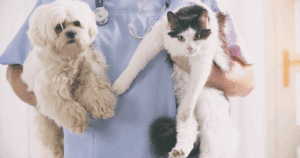
It’s well accepted that widespread, vaccination for dogs, cats and other pets has resulted in control of major deadly infectious diseases.
In some areas, for dogs, canine distemper and adenovirus have been virtually eradicated and the severity and extent of infection with parvovirus significantly reduced.
Vaccination for dogs and other pets has unquestionable benefits, but there are increasing questions surrounding the necessity of annual boosters.
Vaccination for dogs and cats – why do puppies and kittens require so many?
Like human babies, puppies and kittens are at high risk of contracting life-threatening infectious disease.
Cleverly, protection is transferred from mum through antibodies in her colostrum in the first few days of life, but the number of antibodies acquired varies greatly amongst animal litter mates and wanes to an unprotective level over the next couple of months.
That’s where the vaccination for dogs and cats comes into play… there’s a problem to address here as well.
As the number of antibodies decrease there is a point at which there are not enough to protect the baby/pup/kitten from the disease, but there are still sufficient numbers to attack the vaccination and render it useless.
So, whilst all this sounds pretty complicated – and it is – the best method to combat this unpredictability around antibodies and ensure our fur babies are well protected is to start the core vaccine at 6-8 weeks of age and continue with a monthly booster until 16 weeks of age, when we know mum’s antibodies will definitely be out of the picture!
Now we’ve sorted out the reason for puppies and kittens requiring so many vaccinations, the question still remains as to whether adults require annual boosters and what’s in those boosters anyway?
The Australian Veterinary Association, the key Australian authority for Veterinarians, recommends that the core vaccines (life threatening diseases that have a worldwide distribution) be given to all animals, but do not need to be administered any more frequently than every three years in most situations.
This is based on recent scientific research which shows that the duration of immunity provided by many vaccines may be substantially longer than 12 months.
The only exception to this is the first adult vaccine that follows the puppy boosters – this should be given after 12 months.
So what are Core Vaccinations?
In dogs these include: canine distemper virus; canine adenovirus and canine parvovirus and in cats, core vaccinations include feline parvovirus; feline calicivirus and feline herpesvirus.
Non-core vaccinations are those which are only relevant to animals whose location, lifestyle or environment put them at higher risk of contracting infection.
For dogs these commonly include: parainfluenza virus, bordetella bronchiseptica and leptospira interrogans and for cats: feline immunodeficiency virus (FIV) and feline leukemia virus.
The aim of booster vaccination for dogs and cats is to maintain immunity against disease and at the same time minimise the potential for adverse reactions.
Whilst the above recommendations apply to the vast majority of animals, individual vaccination protocols should be determined by a veterinarian based on their assessment of each patient and their needs.
Effects of Vaccination for dogs and cats
There is a lot of discussion about the potential adverse effects of vaccination for dogs and cats. They fall into a spectrum of symptoms with the mildest being a fever, lethargy and a poor appetite that last a few days (and is simply a sign that the vaccine has activated the immune system) to the more severe reactions which include anaphylaxis, auto-immune disease and injection site sarcomas in cats.
A recent large scientific study found that out of 10,000 animals about 30-50 experienced these adverse reactions, that’s an average of 0.4%.
As a veterinarian, we have a duty to you and your pet to objectively examine the current scientific evidence available and advise you accordingly.
My advice, like the majority of the worldwide veterinary population is that whilst adverse reactions do exist, the benefits of protection from potentially deadly infectious disease far outweighs the slight risk of a vaccination reaction.
Titer Testing
So what about titer testing? Can this help determine if and when a patient should have a vaccination? Recent studies have shown that the answer to his questions is a resounding yes!
A blood sample is collected and the number of antibodies to a particular virus or bacteria are assessed, with high levels of antibodies corresponding to good immunity and low levels to the need for a vaccination booster.
There has been some debate about the reliability of these tests but what we now know is that immunity can last for even longer than 3 years after a core vaccination and there is a strong correlation between having sufficient immunity and blood antibody levels for the core vaccine viruses (distemper, parvovirus and adenovirus).
So, the good news is that we now have the option to perform a titer test on a patient every 3 years rather than just vaccinating them. This is especially relevant to patients suffering from illnesses that could be adversely affected by a vaccination.
It is important to note however that dogs and cats living in high risk areas for a particular disease (and your veterinarian will know what these are for you area) should stick to the 3 yearly core vaccine protocol to protect themselves and the population from outbreak.
It’s very easy to forget the potential danger of the diseases we vaccinate against due to their relative scarcity in our society. Both of my parents have childhood memories of one of their puppies dying of distemper, it was common place back then and our pets are now very fortunate to have the option of protection from these nasty, deadly diseases. Parvovirus, adenovirus and distemper all have high mortality rates.
I’ve treated many dogs with Parvovirus, it’s heart breaking and so preventable. This is why it’s so important to ensure that your dog and cat is protected through proper vaccination protocols.
Furthermore, you’ll be helping the entire dog and cat population because if the vast majority of a species in a community are immune to a disease then we end up producing something called Herd Immunity.
What is Herd Immunity?
Herd immunity makes it difficult for diseases to spread when a high enough percentage of individuals are vaccinated against a virus or bacteria – there just not enough susceptible animals left for the bug to infect!
It’s especially crucial for protecting members of the community who cannot be vaccinated such as those who are immunocompromised (cancer patients), ill or too young to vaccinate. When vaccination rates drop, disease rates start to increase so it’s a two-fold effect for which we are all responsible.
If you wish to take your dog to puppy class, doggy day care, or your dog or cat to a boarding facility you do need to remember that these environments can pose greater exposure to disease (just as the train does for us or childcare for our kids!)
It’s not the environment that is at fault, just the higher concentration of individuals in close proximity. For this reason, these facilities are often legally bound to have all in their care vaccinated and up to date with core and in the case of dogs, non core vaccines.
At the end of the day your pet’s health and their ability to safely socialise with others is what is most important to their mental and physical wellbeing.
Your Veterinarian is the best person to talk to about appropriate vaccination for dogs and cats and the correct protocol, the possibility of titre testing and the importance of vaccination against certain diseases before making a final decision.
It can be tough to get cats to the Vet in particular, so click HERE for tips to help (they apply to dogs too!)
Dr Melissa Meehan is a highly experienced and respected veterinary surgeon with over 14 years experience. Dr Melissa obtained her Members in Small Animal Medicine through examination in 2008 and now runs her own veterinary ophthalmology service.

Dog Treat Naturals Superfood Sticks



Poor gut health and dog behaviour issues



Get your paws on Lara Shannon’s best selling books ‘Eat, Play, Love (your dog) and World of Dogs.
Available in Australia, USA, UK and Canada.